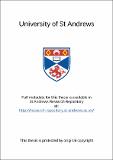Files in this item
The effects of foliar damage on flower characteristics and pollinator visits in Vicia faba
Item metadata
| dc.contributor.author | Orozumbekov, Almazbek Anarbekovich | en |
| dc.coverage.spatial | 92 p | en |
| dc.date.accessioned | 2021-04-08T08:57:12Z | |
| dc.date.available | 2021-04-08T08:57:12Z | |
| dc.date.issued | 2002 | |
| dc.identifier.uri | https://hdl.handle.net/10023/21851 | |
| dc.description.abstract | This thesis addresses aspects of the interaction of plant herbivory and plant pollination. The experiments examine the effects of leaf damage on the flower characteristics of broad beans (Vicia faba) and resultant changes in the visiting behaviour of bees. Early experiments suffered from some experimental inconsistency, and only the later experiments gave results regarded as reliable. Here I found that in broad bean plants, grown under greenhouse conditions, damage to leaves (simulating herbivory) does affect some floral characters. Most importantly, damage (usually at the level of 50% leaf area removal) had the effects of a reduction in the overall number of flowers, decreased flower width, decreased floral nectar concentration (which would lead to lower sugar reward per flower) and at least in some cases a reduction in number of pollen grains per flower. Bumblebees were the most important visitors to field bean flowers, especially Bombus pascuorum and to a lesser extent B. hortorum. Flower visits by bees were more frequent in the afternoon, but trip durations were longer in the morning when nectar rewards were lower. Control (undamaged) plants received more visits overall than either of the two (33% and 50%) damaged groups, and times spent per flower were also usually higher on the control plants compared to damaged plants. For the commonest visitor B pascuorum overall trip lengths were also reduced with 33% and 50% damage, suggesting an ability in this species to detect the effects of damage, either on flower size or on nectar concentration, or on both. Thus, the smaller flowers on damaged plants got fewer and shorter visits overall, and their potential for effective entomophilous pollination may have been reduced. Thus a potential interaction of herbivory levels (as simulated damage) and overall pollination effectiveness is suggested for this species. | en |
| dc.language.iso | en | en |
| dc.publisher | University of St Andrews | en |
| dc.subject.lcc | SB327.O8 | |
| dc.subject.lcsh | Fava bean | en |
| dc.title | The effects of foliar damage on flower characteristics and pollinator visits in Vicia faba | en |
| dc.type | Thesis | en |
| dc.type.qualificationlevel | Doctoral | en |
| dc.type.qualificationname | MPhil Master of Philosophy | en |
| dc.publisher.institution | The University of St Andrews | en |
This item appears in the following Collection(s)
Items in the St Andrews Research Repository are protected by copyright, with all rights reserved, unless otherwise indicated.

